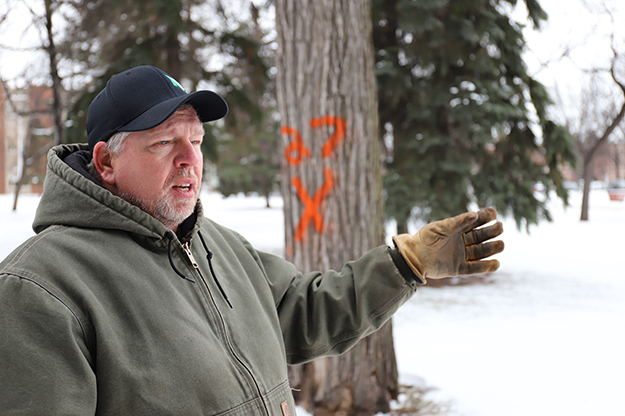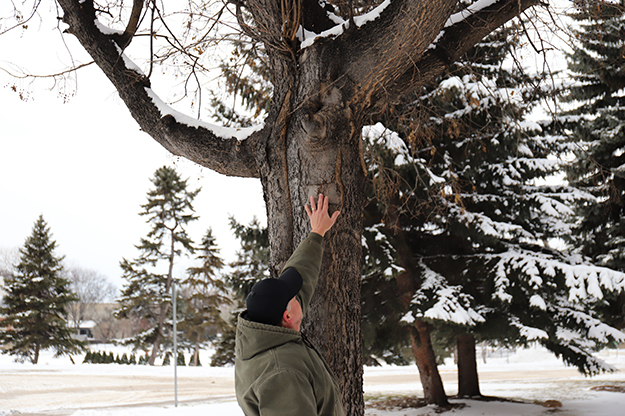Timber!
Campus beautification drives effort to remove diseased trees over winter break, replacement planting set for spring

Implementing the Coulee to Columbia initiative already has had starkly visible results.
Antiquated buildings have been razed; and funding is underway for upgrades to campus cornerstones such as Gamble Hall and the Chester Fritz Library.
Now the initiative is moving from brick and mortar to the University’s roots — quite literally.
Past their prime
The courtyard around the Chester Fritz Library, commonly known as “the quad”, has 22 dead or dying trees that are marked for removal over the course of winter break. These are trees that are either affected by disease or have outlived their golden years, more or less.
“This isn’t a process that happens all that often,” said UND Landscaping Supervisor Dale Kadelbach, who’s overseeing the removal. “Most of the trees in the center of campus could have been planted as long ago as the establishment of the University.
“Several of the trees are elm, which have been affected by Dutch elm disease. Removing them is going to protect other elms that were planted around the same time.”
In taking down diseased trees, there will also be more room for disease-resistant elms to grow.
Other species being removed are spruce and box elder. Kadelbach told UND Today that some of the box elders are upward of 75 years old and have had multiple treatments by trimming their branches. At this point, the continually dying branches are potential hazards on a windy day to students walking in the quad.
As for the spruces, it’s a matter of how they were planted. Growing them in close proximity can lead to damaged bark and branches. They also tend to develop a leaning stance that makes for a gangly appearance.

Clean campus
“An outsourced arborist firm will be on campus from December 18 through January 7 removing the identified trees,” wrote UND Associate Vice President of Facilities Michael Pieper in a statement. “In the spring another outsourced landscape firm will grind the stumps, repair the turf and plant new trees.”
As with other parts of the Coulee to Columbia effort, the goal is to make the stretch of University Avenue between the English Coulee and Columbia Road a place that attracts students.
“This is the heart of campus, and I might suggest that it is the heart of Grand Forks,” UND President Mark Kennedy said of the project earlier this year. “How this looks has an effect on how everyone looks at the rest of campus.”
Biology students involved in undergraduate research teamed up with Facilities Management to count an estimated 5,591 trees on UND grounds.
As for replacing the trees, Kadelbach has other ideas, though he says the goal is to keep them as similar as possible. The now-defunct Ray Richards Golf Course has a plethora of healthy trees and private arborous donations have been successful on campus in the past.
UND Assistant Director of Custodial and Landscaping Chris Ostlie and Kadelbach share in their excitement of the administration’s new direction with the Strategic Plan. The emphasis on presentation has breathed new life into the facilities sector of campus.
“President Kennedy and the administration have given everyone a fresh set of eyes,” said Ostlie, who’s been with the University for 34 years. “After many years, the beauty of campus’s buildings and landscape is out in front.”

Remaining vigilant
Despite the progress thus far, an invasive threat looms on the horizon for UND’s tree life.
The emerald ash borer is a beetle species whose larvae feed on the inner bark of ash trees. They’ve made their way through the American Midwest over the past two decades. In particular, they threaten UND’s multitude of ash that were planted after the 1970s Dutch elm disease era. Pieper said that 35 percent of UND’s trees are ash — which amounts to almost 2,000.
Fortunately, as relayed by Kadelbach, after two consecutive years of surveys by the Department of Agriculture, no signs of the borer beetles exist in the Grand Forks area. The closest cases of infestation have been found in Duluth and Minneapolis, Minn., though it seems like it’s only a matter of time until they arrive.
Given Grand Forks’ status as Tree City USA for the past 31 years (North Dakota’s longest running community), there’s little concern as to the dedication of the area’s arborists.
Mike Fugazzi of the Grand Forks Park District manages forestry operations overseeing 40,000 plus trees in the community. He maintains a working rapport with UND Facilities and their handling of the tree population.
“Our staff does continuing education and workshops on how to identify emerald ash borer,” Fugazzi said. “They’re knowledgeable in recognizing the signs and getting state authorities to further investigate.
“We stopped planting ash trees eight years ago. We’re trying to diversify by planting different trees as well as getting rid of ash that are obstructing power lines and street lights.”
Both Fugazzi and Kadlebach understand the value of proactive caretaking when it comes to protecting both tree populations and the public.
“We’re not just here to chop down trees,” said Kadelbach of UND’s landscapers. “We’re here to keep campus both healthy and safe.”



